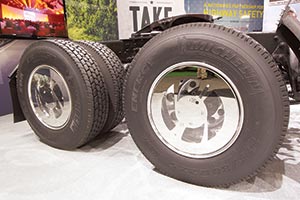Senior Reporter
Tire Price Increases as High as 8% Likely

This story appears in the Feb. 13 print edition of Transport Topics.
Fleets can expect single-digit increases in tire prices soon, as several manufacturers issued price hikes set to take effect this year.
The manufacturers cited higher raw materials costs, market conditions and freight expenses as reasons for increases of up to 8%.
The timing of the price increases sets the table for a round of strenuous bargaining, experts said, as fleets navigate an upward trend in the cost of diesel fuel and leading truckload carriers realized lower profits in the fourth quarter.
Ultimately, the final price for tires comes down to a fleet’s negotiating skill “to get the best dollar,” said Greg Hart, principal of Hart Consulting, which is based in Valparaiso, Indiana. “If you don’t manage [that tire cost], it will eat you alive.” Hart serves as a limited time executive to certain fleets.
At stake are sales of tens of millions of truck tires each year.
“The commercial truck tire market, both original equipment and replacement tires together, is about 15 million a year — and the retread business is about the same,” said Norm Ball, principal of Ball Tire Industry Consultants, based in Kansas City, Missouri.
“The efforts to continually reduce rolling resistance come with a price [for the fleets],” said Ball, who previously worked for 40 years at Michelin North America.
Michelin, Bridgestone Americas Tire Operations, Cooper Tire & Rubber Co., Goodyear Tire & Rubber Co., Toyo Tire U.S.A. Corp., and Yokohama Tire Corp., made separate but closely timed announcements.
Michelin announced that 2012 was the last time it raised prices.
“Thinking back, I can’t remember a time when we went five years [at Michelin] without a price increase. So that is probably a first. [However], you never get to keep all your price increase,” Ball said.
Fleets have a choice of manufacturers, and that is their biggest strength in the negotiation process, Hart said, as is reaching simultaneous deals on recapping tires when the original tread becomes worn.
“When it comes to tire pricing, if one of the big guys wants the business and wants the volume, then they will pull out all the stops,” said Darry Stuart, a limited time executive and a former general chairman of the Technology & Maintenance Council of American Trucking Associations.
Meanwhile, tire technology has continued to improve, as have the reporting systems at fleet yards and in over-the-road situations that the manufacturers offer carriers, Hart said.
But if fleet executives don’t force their people to “manage with those tools [to understand costs], they won’t. And I preach that constantly,” he said.
At the same time, the push for fuel efficiency has caused issues with premature wear and unusual wear patterns on some tires, he said.
As a result, manufacturers are reevaluating compounds and designs, and “the Big Three [Michelin, Bridgestone and Goodyear]” all have an is- sue, every one of them … and they are all engineering that tire to last a lot longer,” Hart said.
For fleets, tires are the second-highest maintenance cost behind aftertreatment systems, said Stuart.
A very small over-the-road trucking operation with only one or a couple of vehicles “is probably going to pay in the lower $400s per tire [from leading brands]. A medium-size but still small fleet probably can sneak into the higher $300s. A high-volume user is probably in the lower $300s and the big, big, megauser is probably on the higher $200s,” he said.
The reality of a tire’s cost, though, is the cost per 1/32nd inch of tread wear, Stuart said. A tire that is $100 less than another may result in the same cost as measured in tread wear or cost per mile, he said.
In the meantime, Bridgestone said — as did others — that its sales and account teams “will soon provide further details to our customers.”




